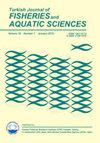Bisphenol A Used in Plastic Industry Negatively Affects Wild Vimba Bream (Vimba vimba)
IF 1.7
4区 农林科学
Q3 FISHERIES
引用次数: 0
Abstract
Used as a component of polycarbonate plastics and epoxy resins in the modern industrial world, bisphenol A (BPA) is one of the highest volume produced industrial chemicals worldwide. BPA causes important environmental problems including endocrine disrupting effect on the organisms in aquatic environments. This study focused on the histopathological, oxidative and hematological effects of long-term BPA exposure on wild vimba bream (Vimba vimba) for the first time. Twenty-five fish stocked in each aquarium and exposed to 1000 μg/L BPA for four weeks. Hematological parameters of fish did not differ significantly compared to control group. The antioxidant activity of liver and gill tissues created a significant partial difference between the groups. According to the histopathological studies, intense hyperplasia and necrosis were detected in the gill tissues of the fish exposed BPA. In addition, hypertrophy and epithelial lifting symptom were partly observed. Vocalization and hypertrophic cells was determined in the liver tissues. In conclusions, this study revealed that BPA had an oxidative and especially histopathologically adverse effects on V. vimba, even though it did not have a hematological effect on the treated fish. Although BPA has adverse effects on the health of aquatic organisms, future studies should focus on the residue in fish meat and risk assessment on human health.塑料工业中使用的双酚A对野生Vimba鲷鱼(Vimba Vimba)产生负面影响
双酚a (BPA)是现代工业世界中聚碳酸酯塑料和环氧树脂的组成部分,是世界上产量最高的工业化学品之一。双酚a会对水生生物产生内分泌干扰等重要的环境问题。本研究首次研究了长期BPA暴露对野生温巴鲷(vimba vimba)的组织病理学、氧化和血液学影响。在每个鱼缸里放了25条鱼,暴露在1000 μg/L的BPA中四周。与对照组相比,鱼的血液学参数无显著差异。肝脏和鳃组织的抗氧化活性在两组之间产生了显著的局部差异。组织病理学检查显示,暴露于双酚a的鱼鳃组织出现了严重的增生和坏死。此外,部分观察到肥大和上皮提升症状。肝组织中有发声细胞和增生性细胞。总之,这项研究揭示了BPA对vimba弧菌有氧化作用,尤其是在组织病理学上的不利影响,尽管它对处理过的鱼没有血液学上的影响。尽管双酚a对水生生物的健康有不良影响,但未来的研究应集中在鱼类中的残留和对人体健康的风险评估上。
本文章由计算机程序翻译,如有差异,请以英文原文为准。
求助全文
约1分钟内获得全文
求助全文
来源期刊

Turkish Journal of Fisheries and Aquatic Sciences
FISHERIES-MARINE & FRESHWATER BIOLOGY
CiteScore
3.10
自引率
0.00%
发文量
43
审稿时长
3 months
期刊介绍:
Turkish Journal of Fisheries and Aquatic Sciences" (TrJFAS) is a refereed academic journal has been published by Central Fisheries Research Institute of Turkey and Japan International Cooperation Agency (JICA), and published in English.
It aims to address research and needs of all working and studying within the many varied areas of fisheries and aquatic sciences.
The Journal publishes English language original research papers, critical review articles, short communications and technical notes on applied or scientific research relevant to freshwater, brackish and marine environments.
TrJFAS was published biannually (April & November) between 2001 and 2009. A great number of manuscripts have been submitted to the journal for review from acceptance of the SCI index. Thereby, the journal has been published quarterly (March, June, September and December) from 2010 to 2017. The journal will be published monthly in 2018.
 求助内容:
求助内容: 应助结果提醒方式:
应助结果提醒方式:


